抄袭的定义(英文权威)
抄袭的认定标准范文
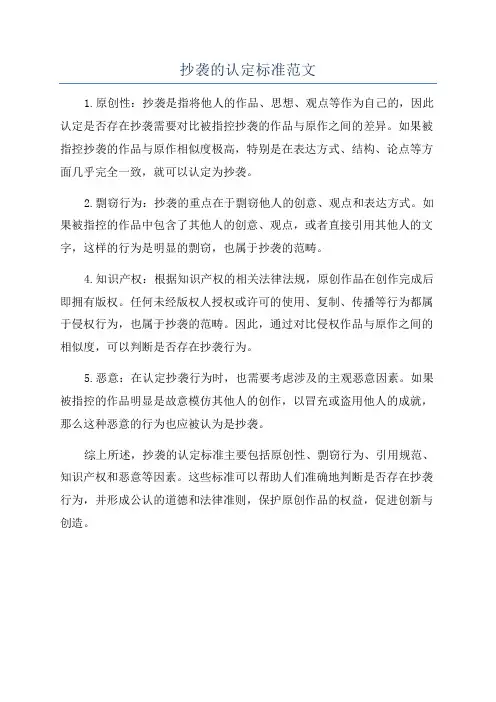
抄袭的认定标准范文
1.原创性:抄袭是指将他人的作品、思想、观点等作为自己的,因此认定是否存在抄袭需要对比被指控抄袭的作品与原作之间的差异。
如果被指控抄袭的作品与原作相似度极高,特别是在表达方式、结构、论点等方面几乎完全一致,就可以认定为抄袭。
2.剽窃行为:抄袭的重点在于剽窃他人的创意、观点和表达方式。
如果被指控的作品中包含了其他人的创意、观点,或者直接引用其他人的文字,这样的行为是明显的剽窃,也属于抄袭的范畴。
4.知识产权:根据知识产权的相关法律法规,原创作品在创作完成后即拥有版权。
任何未经版权人授权或许可的使用、复制、传播等行为都属于侵权行为,也属于抄袭的范畴。
因此,通过对比侵权作品与原作之间的相似度,可以判断是否存在抄袭行为。
5.恶意:在认定抄袭行为时,也需要考虑涉及的主观恶意因素。
如果被指控的作品明显是故意模仿其他人的创作,以冒充或盗用他人的成就,那么这种恶意的行为也应被认为是抄袭。
综上所述,抄袭的认定标准主要包括原创性、剽窃行为、引用规范、知识产权和恶意等因素。
这些标准可以帮助人们准确地判断是否存在抄袭行为,并形成公认的道德和法律准则,保护原创作品的权益,促进创新与创造。
剽窃的定义

互联网也越来越成为学生喜欢用的信息来源, 同样的,学生也必须提供这种来源的详细情况。 所有对他人作品的引用都必须遵循如下规则:
案例4: 列出参考书目
如果出处是书,须提供如下信息:
作者姓名
出版年份
书名
出版地点 出版社的名字 所有引用的页码 版本(如果不只一个版本的话。比如:2001年第三版)
正确做法
学生在写作业时,如果要利用他人的文字或观点,则必须按以下方式 对每个参考之处予以确认:
引用:当从别人的作品中引用直接引语、数字、一般观点或其它信 息时,此作品及其来源必须在文章中出现引用的地方予以承认和 标示;
直接引语: 直接引语必须用引号,并必须标明来源;
引用书目:所有引用书目和其它来源的全部信息都必须在作品(如 论文)的最后一部分列出来,并给出出版物的详细信息。此列单通 常指的是“引用书目”(List of References),它必须包括学生 在作业中所参考的任何所有的信息来源细节。(它与 “参考书 目”(Bibliography)略有不同,后者另外还可能包括你在写作业时 查阅过的参考书目和来源,尽管你在作品中没有直接从中引用)。
以上任何一条都不能成为不承认利用他人作品的理由,因此都构成剽窃行为。
案例2: 引用别人的作品
如果学生希望引用一段文字以支持自己的 文章,正确的做法是使用引号(如 “ ”), 以表示引号里的文字是别人的作品,比如:
“学院或大学建立战略结构的其中一个关键问 题在于,他们各自的行动自由都受到积极和 消极因素的制约” 。
案例
分析一下下面的例子,学生简单地将其读过的 书中的一段文字(斜体部分)直接放在了自己的文 章中:
如何区分参考和抄袭
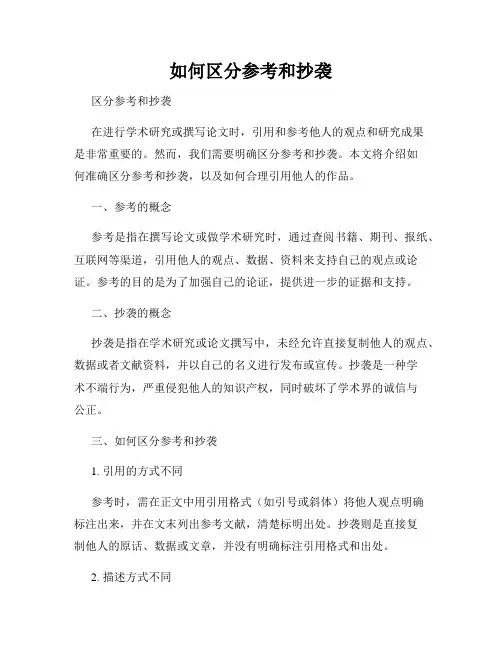
如何区分参考和抄袭区分参考和抄袭在进行学术研究或撰写论文时,引用和参考他人的观点和研究成果是非常重要的。
然而,我们需要明确区分参考和抄袭。
本文将介绍如何准确区分参考和抄袭,以及如何合理引用他人的作品。
一、参考的概念参考是指在撰写论文或做学术研究时,通过查阅书籍、期刊、报纸、互联网等渠道,引用他人的观点、数据、资料来支持自己的观点或论证。
参考的目的是为了加强自己的论证,提供进一步的证据和支持。
二、抄袭的概念抄袭是指在学术研究或论文撰写中,未经允许直接复制他人的观点、数据或者文献资料,并以自己的名义进行发布或宣传。
抄袭是一种学术不端行为,严重侵犯他人的知识产权,同时破坏了学术界的诚信与公正。
三、如何区分参考和抄袭1. 引用的方式不同参考时,需在正文中用引用格式(如引号或斜体)将他人观点明确标注出来,并在文末列出参考文献,清楚标明出处。
抄袭则是直接复制他人的原话、数据或文章,并没有明确标注引用格式和出处。
2. 描述方式不同参考时,可以将他人观点进行自己的解释和陈述,并在文中说明自己的观点与之相符或者不同。
抄袭则是直接将他人观点原封不动地展示出来,没有进行解释和陈述,仅仅是复制粘贴。
3. 思维逻辑不同参考时,我们会从多个来源获取观点和数据来支持自己的主张,形成完整的论证链条。
抄袭者通常只会选择一篇或者少数几篇文章进行复制,思维逻辑不完整,缺乏独立的思考和分析。
4. 社会责任不同参考是一种学术规范,是对他人作品的尊重与崇敬,表示我们在学术界尊重学术共同体的价值观。
抄袭则是对他人劳动成果的侵犯和不负责任的行为,不仅损害他人的劳动成果,也会影响整个学术界的声誉。
四、如何合理引用1. 使用引用标记在文章中使用引号或斜体来标记他人的观点、数据或资料,明确指出这是他人的成果,并在文末列出完整的参考文献引用。
2. 注明出处在引用他人观点或数据时,需要注明出处,如作者姓名、出版年份、书名、期刊名、网页链接等等,确保读者可以在需要时找到原始来源。
剽窃的定义
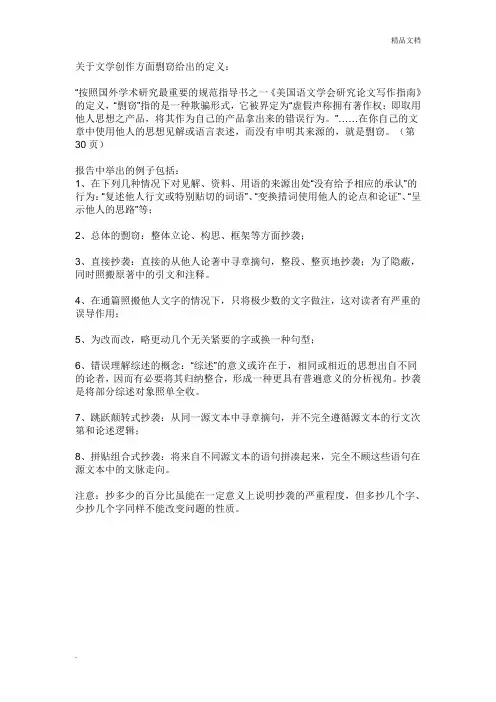
精品文档关于文学创作方面剽窃给出的定义:
“按照国外学术研究最重要的规范指导书之一《美国语文学会研究论文写作指南》的定义,“剽窃”指的是一种欺骗形式,它被界定为“虚假声称拥有著作权:即取用他人思想之产品,将其作为自己的产品拿出来的错误行为。
”……在你自己的文章中使用他人的思想见解或语言表述,而没有申明其来源的,就是剽窃。
(第30页)
报告中举出的例子包括:
1、在下列几种情况下对见解、资料、用语的来源出处“没有给予相应的承认”的行为:“复述他人行文或特别贴切的词语”、“变换措词使用他人的论点和论证”、“呈示他人的思路”等;
2、总体的剽窃:整体立论、构思、框架等方面抄袭;
3、直接抄袭:直接的从他人论著中寻章摘句,整段、整页地抄袭;为了隐蔽,同时照搬原著中的引文和注释。
4、在通篇照搬他人文字的情况下,只将极少数的文字做注,这对读者有严重的误导作用;
5、为改而改,略更动几个无关紧要的字或换一种句型;
6、错误理解综述的概念:“综述”的意义或许在于,相同或相近的思想出自不同的论者,因而有必要将其归纳整合,形成一种更具有普遍意义的分析视角。
抄袭是将部分综述对象照单全收。
7、跳跃颠转式抄袭:从同一源文本中寻章摘句,并不完全遵循源文本的行文次第和论述逻辑;
8、拼贴组合式抄袭:将来自不同源文本的语句拼凑起来,完全不顾这些语句在源文本中的文脉走向。
注意:抄多少的百分比虽能在一定意义上说明抄袭的严重程度,但多抄几个字、少抄几个字同样不能改变问题的性质。
.。
抄袭剽窃行业认定的标准
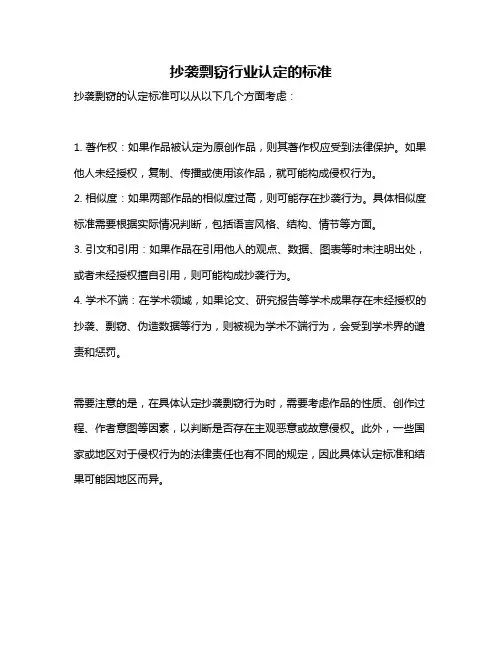
抄袭剽窃行业认定的标准
抄袭剽窃的认定标准可以从以下几个方面考虑:
1. 著作权:如果作品被认定为原创作品,则其著作权应受到法律保护。
如果他人未经授权,复制、传播或使用该作品,就可能构成侵权行为。
2. 相似度:如果两部作品的相似度过高,则可能存在抄袭行为。
具体相似度标准需要根据实际情况判断,包括语言风格、结构、情节等方面。
3. 引文和引用:如果作品在引用他人的观点、数据、图表等时未注明出处,或者未经授权擅自引用,则可能构成抄袭行为。
4. 学术不端:在学术领域,如果论文、研究报告等学术成果存在未经授权的抄袭、剽窃、伪造数据等行为,则被视为学术不端行为,会受到学术界的谴责和惩罚。
需要注意的是,在具体认定抄袭剽窃行为时,需要考虑作品的性质、创作过程、作者意图等因素,以判断是否存在主观恶意或故意侵权。
此外,一些国家或地区对于侵权行为的法律责任也有不同的规定,因此具体认定标准和结果可能因地区而异。
如何认定抄袭、剽窃行为的探讨论文
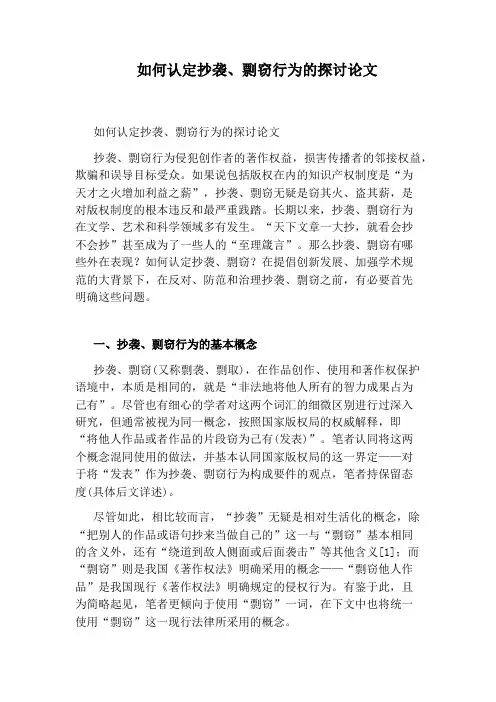
如何认定抄袭、剽窃行为的探讨论文如何认定抄袭、剽窃行为的探讨论文抄袭、剽窃行为侵犯创作者的著作权益,损害传播者的邻接权益,欺骗和误导目标受众。
如果说包括版权在内的知识产权制度是“为天才之火增加利益之薪”,抄袭、剽窃无疑是窃其火、盗其薪,是对版权制度的根本违反和最严重践踏。
长期以来,抄袭、剽窃行为在文学、艺术和科学领域多有发生。
“天下文章一大抄,就看会抄不会抄”甚至成为了一些人的“至理箴言”。
那么抄袭、剽窃有哪些外在表现?如何认定抄袭、剽窃?在提倡创新发展、加强学术规范的大背景下,在反对、防范和治理抄袭、剽窃之前,有必要首先明确这些问题。
一、抄袭、剽窃行为的基本概念抄袭、剽窃(又称剽袭、剽取),在作品创作、使用和著作权保护语境中,本质是相同的,就是“非法地将他人所有的智力成果占为己有”。
尽管也有细心的学者对这两个词汇的细微区别进行过深入研究,但通常被视为同一概念,按照国家版权局的权威解释,即“将他人作品或者作品的片段窃为己有(发表)”。
笔者认同将这两个概念混同使用的做法,并基本认同国家版权局的这一界定——对于将“发表”作为抄袭、剽窃行为构成要件的观点,笔者持保留态度(具体后文详述)。
尽管如此,相比较而言,“抄袭”无疑是相对生活化的概念,除“把别人的作品或语句抄来当做自己的”这一与“剽窃”基本相同的含义外,还有“绕道到敌人侧面或后面袭击”等其他含义[1];而“剽窃”则是我国《著作权法》明确采用的概念——“剽窃他人作品”是我国现行《著作权法》明确规定的侵权行为。
有鉴于此,且为简略起见,笔者更倾向于使用“剽窃”一词,在下文中也将统一使用“剽窃”这一现行法律所采用的概念。
二、抄袭、剽窃行为的客观构成要件相对于主观过错、损害事实、因果关系等民事侵权行为的其他构成要件,剽窃行为的复杂性主要在于其客观表现。
具体来说,剽窃行为的构成在客观上需要满足如下全部要件:1.在自己作品中使用了他人作品或他人作品的片段。
所谓他人作品是指由他人享有署名权、适用著作权法保护的作品。
学术抄袭的英文作文
学术抄袭的英文作文Academic plagiarism is a serious issue that can have severe consequences for students and scholars. It involves the act of using someone else's work or ideas withoutproper citation or acknowledgment. This can include copying and pasting text from a source without quotation marks or failing to give credit to the original author.Plagiarism undermines the integrity of the academic community and devalues the hard work and originality of others. It can also lead to legal and ethical repercussions, such as academic penalties, loss of reputation, and even legal action in some cases.In today's digital age, it has become easier for individuals to access and copy information from theinternet without proper attribution. This has led to an increase in cases of plagiarism, as some may not fully understand the importance of academic integrity or the consequences of their actions.Educational institutions and publishers have implemented various measures to detect and prevent plagiarism, such as using plagiarism detection software and promoting awareness of ethical writing practices. However, ultimately, it is up to individuals to uphold their own integrity and take responsibility for their work.To avoid plagiarism, it is essential to properly cite all sources used in academic writing, including paraphrased or summarized information. Additionally, developing good research and writing habits, such as taking detailed notes and creating original arguments, can help prevent unintentional plagiarism.In conclusion, academic plagiarism is a serious issue that can have far-reaching consequences. It is importantfor individuals to understand the ethical and legal implications of plagiarism and to take proactive measures to avoid it. By upholding academic integrity and respecting the work of others, we can contribute to a more honest and respectful academic community.。
论文抄袭剽窃标准的界定
论文剽窃标准的界定更多关于论文抄袭检测的文章,请查看520check官网。
美国《电化学学会杂志》最近发表一篇社论,对剽窃行为做出了严厉的批评,特别提到吉林大学电子工程学院王金忠博士等人去年在《晶体生长杂志》上发表的一篇论文抄袭了《电化学学会杂志》和《应用物理通讯》上的论文,并已将这篇文章撤销。
事实上,早在去年4月初王金忠等人的论文刚发表时,就有人向我反映过这起剽窃案,而该论文的其他作者也曾写信给我澄清说这篇论文是王金忠一个人在他们不知情的情况下写的,署名和投稿都没有经过其他作者的同意。
这是今年以来国际学术期刊第三次揭露、批评中国研究人员剽窃。
另两次是:《模式识别通讯》发表撤销论文声明,指出北方交通大学袁保宗、文富荣去年发表在该刊上的一篇论文为剽窃之作,应予撤销;《电子学通讯》发表社论,揭露上海交通大学电子系宋阳、胡光锐去年发表在该刊上的一篇论文几乎完全剽窃自哈穆·勾德曼(Haim Goldman)在1988年和1990年发表的两篇论文。
这些剽窃论文,有的是从文字表述到研究成果都全盘剽窃,例如宋阳、光锐的论文;有的则是在引言、分析部分大段大段地抄袭别人的文字表述,研究成果倒可能是自己得出的。
后一种情形在国内研究人员中相当普遍,在我们揭露的剽窃案中,有很大一部分属于此类,而剽窃者往往来函辩解说,他们是因为英语水平有限,所以借鉴、套用了国外论文的表述,但是实验数据和结果是自己的,因此不算剽窃。
例如最近我们披露今年院士候选人、南开大学廖代正等人发表的论文被国际期刊揭发抄袭之后,其学生代表廖教授发表声明理直气壮地声称:“因为英文水平有限,所以我写英文文章时借鉴了那些母语为英语的同行发表的相关文章,甚至原封不动地摘抄了一些语句,这是我个人的问题,以后我肯定会多加注意!与文科类文献不同,即使在化学专业学术论文中原封不动地借鉴了文献中的某些语句,但只要报道的是自己的研究结果和结论,就和抄袭没有任何关系!因为化学文献注重的是实验方法、数据和结论,而不是个别单词或者语句的写法。
如何定义英文论文抄袭?
对于文字抄袭的定义,有一个定义为:连续50个单词与其他论文段落一模一样,即为抄袭(文字上的)。
但如果你给出了引述的出处,而不是据为己有,则也不算抄袭,只能算是引用。
曾经见到两个外国作者引述同一个作者的一段话,数了一下字数,共有93个连续的单词一模一样,但在引述后边给出了出处,也很正常。
也没有见到哪个作者要告另一个作者。
那些少见多怪的人往往是没有写过甚至读过SCI论文,他们是一些生手,不懂的SCI论文的要义。
如果你经常看SCI论文或文献的话,你就会发现很多作者在讨论中大量引用别人论文中的话语,看的多了都不会觉得有什么奇怪的,同样的语句不止出现在一个作者的论文中,弄到最后你都不知道一句话谁是始作俑者。
也没有见到有哪个作者要告哪个作者,千万别自己吓唬自己。
首先我们要搞明白写论文什么是最重要的。
论文中最重要的部分就是结果,也即自己的研究结果,只要自己的研究结果是自己通过辛苦劳累得来的,那研究结果就是自己的,在讨论中讨论有关自己的研究结果时引用一下别人论文中的讨论或语句很正常,没有什么可怕的。
而且对自己研究结果的现状、过去进行讨论时,别人往往对此已经做过很经典的论述了,引用别人现成的论述要比你自己现写的语句更有说服力,况且引用时你要给出索引文献,而不是据为己有,这当然很正常了,没有什么异常的,大家是可以接受的。
这种大量引用别人论文的情况,中国人还算是少的呢,因为中国人的SCI论文并不多,我常常见到很多外国人写的论文都是大量引用别人的语句,这有什么稀罕的呢?我已经发表了几十篇的SCI 论文,讨论中经常引用别人对该研究的现状和过去历史的总结,也没有哪个作者要告我说用了他的话了!担心被告的人真是没有搞清楚论文的要义,只要你的研究结果是自己的,你的论文就是真实的,就是你的,就不是抄袭!文字引用要给出索引文献,否则,真有点文字抄袭的味道!我在这里简单谈谈SCI收录论文的写作问题:SCI论文有前言、材料与方法、结果和讨论,这是论著的一般形式。
写英文作文抄袭的评语
写英文作文抄袭的评语英文回答:Cheating in writing an English essay is a serious academic offense that should not be taken lightly. Not only does it undermine the integrity of the educational system, but it also hinders personal growth and development. As a student, I understand the temptation to plagiarize or copy someone else's work, especially when facing timeconstraints or difficulties in understanding the topic. However, I firmly believe that it is essential to take responsibility for our own learning and strive for academic honesty.Firstly, copying someone else's work deprives us of the opportunity to develop our own critical thinking andwriting skills. By relying on others' ideas and words, we fail to engage with the material and truly understand it.It is through the process of researching, analyzing, and synthesizing information that we enhance our knowledge andexpand our intellectual horizons. For instance, when I wrote my last essay on the impact of social media on society, I had to conduct extensive research, read various articles, and critically evaluate different perspectives. This process allowed me to form my own opinions and present a well-rounded argument, which would not have been possible if I had simply copied someone else's work.Secondly, cheating not only affects our individual growth but also undermines the trust and fairness within the academic community. When we cheat, we are essentially stealing someone else's intellectual property and claiming it as our own. This not only diminishes the value of our own achievements but also devalues the hard work andefforts of others. For example, imagine if a classmate of mine spends hours researching and writing an essay, only to find out that someone else has copied it and received the same grade. This creates a sense of injustice and erodes the trust and fairness that should exist in the educational environment.Moreover, cheating in writing an essay can have severeconsequences, both academically and personally. From an academic perspective, it can result in failing grades, academic probation, or even expulsion from school. These consequences not only affect our academic record but also limit future opportunities, such as scholarships or admission to higher education institutions. On a personal level, cheating can lead to feelings of guilt, shame, and a lack of self-confidence. It erodes our sense of integrity and character, making it difficult to build trust and credibility in other aspects of life.中文回答:写英文作文抄袭是一种严重的学术不端行为,不应该被轻视。
- 1、下载文档前请自行甄别文档内容的完整性,平台不提供额外的编辑、内容补充、找答案等附加服务。
- 2、"仅部分预览"的文档,不可在线预览部分如存在完整性等问题,可反馈申请退款(可完整预览的文档不适用该条件!)。
- 3、如文档侵犯您的权益,请联系客服反馈,我们会尽快为您处理(人工客服工作时间:9:00-18:30)。
Defining and Avoiding Plagiarism: The WPA Statement on Best PracticesDownload a PDF version of this document.Plagiarism has always concerned teachers and administrators, who want students’ work to repre sent their own efforts and to reflect the outcomes of their learning. However, with the advent of the Internet and easy access to almost limitless written material on every conceivable topic, suspicion of student plagiarism has begun to affect teachers at all levels, at times diverting them from the work of developing students’ writing, reading, and critical thinking abilities. This statement responds to the growing educational concerns about plagiarism in four ways: by defining plagiarism; by suggesting some of the causes of plagiarism; by proposing a set of responsibilities (for students, teachers, and administrators) to address the problem of plagiarism; and by recommending a set of practices for teaching and learning that can significantly reduce the likelihood of plagiarism. The statement is intended to provide helpful suggestions and clarifications so that instructors, administrators, and students can work together more effectively in support of excellence in teaching and learning. What Is Plagiarism?In instructional settings, plagiarism is a multifaceted and ethically complex problem. However, if any definition of plagiarism is to be helpful to administrators, faculty, and students, it needs to be as simple and direct as possible within the context for which it is intended.Definition: In an instructional setting, plagiarism occurs when a writer deliberately uses someone else’s language,ideas, or other original (not common-knowledge) material without acknowledging its source.This definition applies to texts published in print or on-line, to manuscripts, and to the work of other student writers.Most current discussions of plagiarism fail to distinguish between:1.submitting someone else’s text as one’s own or attempting toblur the line between one’s own ideas or words and thoseborrowed from another source, and2.carelessly or inadequately citing ideas and words borrowedfrom another source.Such discussions conflate plagiarism with the misuse of sources.Ethical writers make every effort to acknowledge sources fully and appropriately in accordance with the contexts and genres of their writing. A student who attempts (even if clumsily) to identify and credit his or her source, but who misuses a specific citation format or incorrectly uses quotation marks or other forms of identifying material taken from other sources, has not plagiarized. Instead, such a student should be considered to have failed to cite and document sources appropriately.What are the Causes of Plagiarism and the Failure to Use and Document Sources Appropriately?Students who are fully aware that their actions constitute plagiarism—for example, copying published information into a paper without source attribution for the purpose of claiming the information as their own, or turning in material written by another student—are guilty of academic misconduct. Although no excuse will lessen the breach of ethical conduct that such behavior represents, understanding why students plagiarize can help teachers to consider how to reduce the opportunities for plagiarism in their classrooms.∙Students may fear failure or fear taking risks in their own work.∙Students may have poor time-management skills or they may plan poorly for the time and effort required for research-based writing, and believe they have no choice but to plagiarize.∙Students may view the course, the assignment, the conventions of academic documentation, or the consequences of cheating as unimportant.∙Teachers may present students with assignments so generic or unparticularized that students may believe they are justified in looking for canned responses.∙Instructors and institutions may fail to report cheating when it does occur, or may not enforce appropriate penalties.Students are not guilty of plagiarism when they try in good faith to acknowledge others’ work but fail to do so accurately or fully. These failures are largely the result of failures in prior teaching and learning:students lack the knowledge of and ability to use the conventions of authorial attribution. The following conditions and practices may result in texts that falsely appear to represent plagiarism as we have defined it:∙Students may not know how to integrate the ideas of others and document the sources of those ideas appropriately in theirtexts.∙Students will make mistakes as they learn how to integrate others’ words or ideas into their own work because error is anatural part of learning.∙Students may not know how to take careful and fully documented notes during their research.∙Academicians and scholars may define plagiarism differently or more stringently than have instructors or administrators instudents’ ear lier education or in other writing situations.∙College instructors may assume that students have already learned appropriate academic conventions of research anddocumentation.∙College instructors may not support students as they attempt to learn how to research and document sources; instead,instructors may assign writing that requires research andexpect its appropriate documentation, yet fail to appreciate the difficulty of novice academic writers to execute these taskssuccessfully.∙Students from other cultures may not be familiar with the conventions governing attribution and plagiarism in Americancolleges and universities.∙In some settings, using other people’s words or ideas as their own is an acceptable practice for writers of certain kinds of texts (for example, organizational documents), making the concepts of plagiarism and documentation less clear cut than academics often acknowledge and thereby confusing students who havenot learned that the conventions of source attribution vary indifferent contexts.What are our Shared Responsibilities?When assignments are highly generic and not classroom-specific, when there is no instruction on plagiarism and appropriate source attribution, and when students are not led through the iterative processes of writing and revising, teachers often find themselves playing an adversarial role as “plagiarism police” instead of a coaching role as educators. Just as students must live up to their responsibility to behave ethically and honestly as learners, teachers must recognizethat they can encourage or discourage plagiarism not just by policy and admonition, but also in the way they structure assignments and in the processes they use to help students define and gain interest in topics developed for papers and projects.Students should understand research assignments as opportunities for genuine and rigorous inquiry and learning. Such an understanding involves:∙Assembling and analyzing a set of sources that they have themselves determined are relevant to the issues they areinvestigating;∙Acknowledging clearly when and how they are drawing on the ideas or phrasings of others;∙Learning the conventions for citing documents andacknowledging sources appropriate to the field they arestudying;∙Consulting their instructors when they are unsure about how to acknowledge the contributions of others to their thought andwriting.Faculty need to design contexts and assignments for learning that encourage students not simply to recycle information but to investigate and analyze its sources. This includes:∙Building support for researched writing (such as the analysis of models, individual/group conferences, or peer review) intocourse designs;∙Stating in writing their policies and expectations for documenting sources and avoiding plagiarism;∙Teaching students the conventions for citing documents and acknowledging sources in their field, and allowing students topractice these skills;∙Avoiding the use of recycled or formulaic assignments that may invite stock or plagiarized responses;∙Engaging students in the process of writing, which produces materials such as notes, drafts, and revisions that are difficult to plagiarize;∙Discussing problems students may encounter in documenting and analyzing sources, and offering strategies for avoiding orsolving those problems;∙Discussing papers suspected of plagiarism with the students who have turned them in, to determine if the papers are theresult of a deliberate intent to deceive;∙Reporting possible cases of plagiarism to appropriate administrators or review boards.Administrators need to foster a program- or campus-wide climate that values academic honesty. This involves:∙Publicizing policies and expectations for conducting ethical research, as well as procedures for investigating possible cases of academic dishonesty and its penalties;∙Providing support services (for example, writing centers or Web pages) for students who have questions about how to citesources;∙Supporting faculty and student discussions of issues concerning academic honesty, research ethics, and plagiarism;∙Recognizing and improving upon working conditions, such as high teacher-student ratios, that reduce opportunities for more individualized instruction and increase the need to handlepapers and assignments too quickly and mechanically;∙Providing faculty development opportunities for instructors to reflect on and, if appropriate, change the ways they work with writing in their courses.Best PracticesCollege writing is a process of goal setting, writing, giving and using feedback, revising, and editing. Effective assignments construct specific writing situations and build in ample room for response and revision. There is no guarantee that, if adopted, the strategies listed below will eliminate plagiarism; but in supporting students throughout their research process, these strategies make plagiarism both difficult and unnecessary.1. Explain Plagiarism and Develop Clear Policies∙Talk about the underlying implications of plagiarism.Remind students that the goal of research is to engage, through writing, in a purposeful, scholarly discussion of issues that are sometimes passed over in daily life. Understanding,augmenting, engaging in dialogue with, and challenging thework of others are part of becoming an effective citizen in acomplex society. Plagiarism does not simply devalue theinstitution and the degree it offers; it hurts the inquirer, whohas avoided thinking independently and has lost theopportunity to participate in broader social conversations.∙Include in your syllabus a policy for using sources, and discuss it in your course. Define a policy that clearly explains the consequences of both plagiarism (such as turning in a paper known to be written by someone else) and the misuse orinaccurate citation of sources.∙If your university does not already have one, establish an honor code to which all students subscribe; a judicial board to hear plagiarism cases; or a departmentalombudsperson to hear cases brought between students and instructors.2. Improve the Design and Sequence of Assignments∙Design assignments that require students to explore a subject in depth. Research questions and assignment topics should be based on principles of inquiry and on the genuineneed to discover something about the topic, and should present that topic to an audience in the form of an exploration or anargument.∙Start building possible topics early. Good writing reflects a thorough understanding of the topic being addressed orresearched. Giving students time to explore their topics slowly and helping them to narrow their focus from broad ideas tospecific research questions will personalize their research andprovide evidence of their ongoing investigations∙Consider establishing a course theme, and then allow students to define specific questions about that theme so that they become engaged in learning new ideas andbegin to own their research. A course theme (like “literacy”or “popular culture”) allows students and in structor to develop expertise and to support each other as they read, write, andengage in their research. Grounding the theme in a localcontext (such as the campus, or the neighborhood or city where the campus is located) can provide greater relevance tostudents’ lives. Once stu dents have defined a topic within thecourse theme, ask them to reflect frequently on their choice of topic: about what they already know about the topic when they begin their research; about what new ideas they are learningalong the way; and about what new subjects for research they are discovering.∙Develop schedules for students that both allow them time to explore and support them as they work towarddefined topics. As researchers learn more about their subjects, they typically discover new, unforeseen questions and interests to explore. However, student researchers do not have unlimited time for their work—at some point, they must choose a focus for their papers. Conferences with students (sometimes held in the library or computer resource center) are invaluable for enabling them to refine their focus and begin their inquiry.∙Support each step of the research process. Students often have little experience planning and conducting research. Using planning guides, in-class activities, and portfolios, instructorsshould “stage” students’ work and provide support at eachstage—from invention to drafting, through revision andpolishing. Collecting interim materials (such as annotatedphotocopies) helps break the research assignment down intoelements of the research process while providing instructorswith evidence of students’ original work. Building “low-st akes”writing into the research process, such as reflective progressreports, allows instructors to coach students more effectivelywhile monitoring their progress.∙Make the research process, and technology used for it, visible. Ask your students to consider how varioustechnologies—computers, fax machines, photocopiers,e-mail—affect the way information is gathered and synthesized, and what effect these technologies may have on plagiarism.∙Attend to conventions of different genres of writing. As people who read and write academic work regularly, instructors are sensitive to differences in conventions across differentdisciplines and, sometimes, within disciplines. However,students might not be as aware of these differences. Planactivities—like close examinations of academic readings—thatask students to analyze and reflect on the conventions indifferent disciplines.3. Attend to Sources and the Use of Reading∙Ask students to draw on and document a variety of sources. Build into your assignments additional sources, such as systematic observation, interviews, simple surveys, or other datagathering methods. Incorporating a variety of sources can help students develop ways of gathering, assessing, reading,and using different kinds of information, and can make for alivelier, more unique paper.∙Consider conventions. Appropriate use of citations depends on students’ familiarity with the conventions of the genre(s)they are using for writing. Design activities that help students to become familiar with these conventions and make informedchoices about when and where to employ them.∙Show students how to evaluate their sources. Provide opportunities for students to discuss the quality of the content and context of their sources, through class discussions,electronic course management programs or Internet chatspaces, or reflective assignments. Discuss with students howtheir sources will enable them to support their argument ordocument their research.∙Focus on reading. Successful reading is as important to thoughtful research essays as is successful writing. Developreading-related heuristics and activities that will help students to read carefully and to think about how or whether to use that reading in their research projects.4. Work on Plagiarism Responsibly∙Distinguish between misuse of sources and plagiarism. If students have misused sources, they probably do notunderstand how to use them correctly. If this is the case, work with students so that they understand how to incorporate and cite sources correctly. Ask them to rewrite the sections where sources have been misused.∙Ask students for documentation. If a student’s work raises suspicions, talk with him or her about your concerns. Askstudents to show you their in-process work (such as sources,summaries, and drafts) and walk you through their researchprocess, describing how it led to the production of their draft. If they are unable to do this, discuss with them the consequences of plagiarism described in your syllabus (and, perhaps, by your institution). If you have talked with a student and want topursue your own investigation of his or her work, turn tosources that the student is likely to have used and look forevidence of replication.∙Use plagiarism detection services cautiously. Although such services may be tempting, they are not always reliable.Furthermore, their availability should never be used to justifythe avoidance of responsible teaching methods such as thosedescribed in this document.5. Take Appropriate Disciplinary Actions∙Pay attention to institutional guidelines. Many institutions have clearly defined procedures for pursuing claims of academic dishonesty. Be sure you have read and understood these before you take any action.∙Consider your goal. If a student has plagiarized, consider what the student should take away from the experience. Insome cases, a failing grade on the paper, a failure in the course, academic probation, or even expulsion might achieve thosegoals. In other cases, recreating the entire research process,from start to finish, might be equally effective.Council of Writing Program Administrators, January, 2003。
